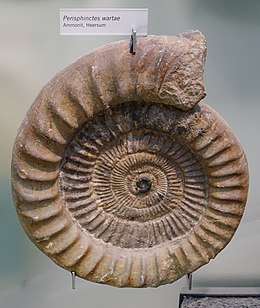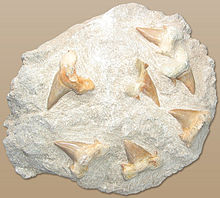Fossil
![]()
This article is about fossilized and other evidence of dead living things. For other meanings, see Fossil (disambiguation).
A fossil (Latin fossilis 'excavated') is any evidence of past life in the history of the Earth that is older than 10,000 years and can thus be assigned to a geological age before the beginning of the Holocene. Such geological documents can be both physical remains of living beings (body fossils) and evidence of their activity (trace fossils). For example, fossilized stepping stones and excrement (coprolites) are also counted as fossils. The formation of fossils is called fossilization. The study of fossils is primarily carried out by palaeontology.
The term "fossilization" or obsoletely "petrefact" (Latin petra [from ancient Greek πέτρα] stone, factum "made") is not synonymous, for not every fossil is mineralized and thus exists as a fossilization.
According to scientifically based estimates, about one billion animal and plant species have evolved since the beginning of the Phanerozoic Era 541 million years ago, and most of them have become extinct again. Some estimates even put the figure at 1.6 billion. Far less than one percent of this species richness has been preserved in fossil form, not only because of the special circumstances required for fossilization, but also because many fossils have been destroyed again over millions of years as a result of weathering, erosion or rock metamorphosis. By 1999, around 250,000 fossil species had been scientifically described.

Ammonites ("Ammon horns") are among the best known and most popular fossils. Here a representative of the species Perisphinctes wartae from the Upper Jurassic of the Innerstebergland (southern Lower Saxony).
Historical
The discovery of marine organisms in rocks on the mainland attracted attention in ancient and medieval times from China to Europe, and they were correctly interpreted by several scholars (including Xenophanes, Eratosthenes, Leonardo da Vinci) as the remains of organisms or the remains of a former sea cover. On the other hand, the ancient Greek philosopher Aristotle and the scholastics based on his teachings regarded them as the whims of nature (lusus naturae).
The term fossil was first used in 1546 by Georgius Agricola in his work De natura fossilium. While, as Agricola did, all curiosities found "during excavation" were initially referred to indiscriminately as fossils, including minerals, artefacts, strangely shaped roots or concretions, in the course of time the meaning was narrowed to objects that testified to the existence of prehistoric life. The Frenchman Jean-Baptiste Lamarck made a significant contribution to this with the chapter Sur les fossiles in his comprehensive work on the systematics of invertebrates, which appeared in 1801. Common names for fossils were also petrefact and fossilization, and indeed in many cases fossils are formed by organic matter being replaced by mineral substance. Accordingly, the predecessor of modern paleontology was called petrefactology until well into the 19th century. As early as 1667, the Dane Nicolaus Steno was the first modern scholar to prove that fossils are not the vagaries of nature, but the remains of living beings from an earlier time.

Fossil teeth of the Eocene shark Otodus obliquus. Such teeth were long interpreted as tongue stones (glossopetrae), among other things, and were only correctly recognized in the 17th century. Since sharks form new teeth throughout their lives (revolver dentition), shark teeth are among the most common vertebrate finds, whereas the cartilaginous shark skeleton is only rarely preserved in fossils.
Noun fossil vs. adjective fossil
In addition to the term fossil as a noun, the word is also used as an adjective to characterize objects or formations that are geologically relatively old. In this sense, the adjective fossil is still used today not exclusively for the remains of living beings, for example in the word combination fossil energy sources (coal, oil, natural gas) or fossil water (very old deep groundwater). The opposite of the adjective fossil is recent. It refers to all formations that are relatively young geologically. Geological evidence whose age is on the borderline between fossil and recent can be called subfossil or subrecent. This concerns formations from the Quaternary period up to about 8000 BC (see also → Prehistory). In palaeobotany, however, subfossil also often refers to incomplete fossilization, i.e. a particular state of preservation. In this sense, even floras from the Palaeogene (older than 25 million years) can still be considered subfossil.
In biology and paleontology, the adjective fossil is also used to refer to extinct species. Fossil species" are those species that became extinct before the turn from the Pleistocene to the Holocene, i.e. more than about 12,000 years ago. Fossil species can be contrasted with recent species that became extinct only in the Holocene or that still exist today. The so-called living fossils are also (recent) species, not individual specimens. The totality of all fossil species currently known to science and their occurrence is called the fossil record.
In geomorphology, surface forms that still exist today but whose formation process came to a standstill in the geological past (so-called inactive structures) are referred to as fossil. This also applies to formations that are significantly younger than 10,000 years, for example inactive Holocene cliffs in landfall areas of the German Baltic Sea coast.
Questions and Answers
Q: What is a fossil?
A: A fossil is the remains or trace of an ancient living thing that has been mineralised or petrified (literally, turned into rock). It can be bones, shells, exoskeletons, stone imprints of animals or microbes, objects preserved in amber, hair, petrified wood, oil, coal and DNA remnants.
Q: How are fossils formed?
A: Fossils are formed when the body form of an ancient living thing is retained but the original molecules that made up the body have been replaced by some inorganic material such as calcium carbonate (CaCO3) or silica (SiO2).
Q: What type of organisms are most commonly found as fossils?
A: The most common fossils are those left behind by organisms that produce hard materials such as molluscs (clams and snails) and brachiopods (lampshells).
Q: Are there any examples of soft-bodied organisms being found as fossils?
A: Yes. Soft-bodied organisms can fossilise in special circumstances - for example the Ediacaran biota.
Q: What do people study when they look at fossils?
A: People who study fossils are known as paleontologists. If they put living things in their ecological context it is called paleobiology.
Q: Are there any famous examples of fossils?
A: Yes. The best-known fossils for the general public are those of giant prehistoric dinosaurs - their fossilized bones and tracks can be seen in many museums around the world.
Search within the encyclopedia